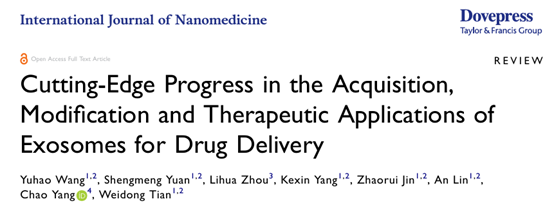外泌体是细胞分泌至其胞外的纳米级别的囊泡,携带丰富的DNA、RNA、蛋白质等,它通过旁分泌、自分泌等方式参与细胞识别、信号传导等生物学过程,是细胞之间沟通交流的新型工具。外泌体本身具有良好的生物相容性、稳定性及靶向性,并且还可以通过多种方法进行工程化修饰,是一种良好的药物传递系统。目前外泌体已作为递送系统广泛的应用于心脑血管疾病、神经系统疾病、肿瘤等多种疾病的治疗之中。
四川大学华西口腔医院田卫东教授团队在International Journal of Nanomedicine杂志上发表题为“Cutting-Edge Progress in the Acquisition, Modification and Therapeutic Applications of Exosomes for Drug Delivery”的论文,主要介绍了外泌体分离提纯方法、工程化外泌体制备及临床应用的前沿进展。 第一作者王宇豪,通讯作者杨超研究员、田卫东教授。
一、外泌体的分离
目前,基于外泌体粒径、密度、表面标志等特点,研究者已经开发出多种分离纯化技术,包括超速离心、密度梯度离心、超滤法、尺寸排阻色谱法、聚合物沉淀技术、亲和分离技术以及微流控技术等。目前,还出现了很多新兴高效的外泌体提纯系统,例如,负压振荡系统(NPO)结合双耦合谐波振荡系统(HO)作用于纳米超滤芯片,使得样本中的游离核酸与蛋白等杂质通过纳米孔快速去除并截留外泌体,从而纯化富集外泌体。在未来,设备集成化、自动化设计将是另一个新的外泌体纯化方向,它可以快速处理大量样本,提高实验效率,降低时间及人工成本,解决现阶段外泌体大规模制备的难题。
Table 1.外泌体分离方法
| Separation method | Principle | Advantage | Drawbacks | Separation efficiency | Scope of Application |
| Ultracentrifugation | Step-by-step separation based on density, size, and dimensions | Uncontaminated by isolation reagents; a large number of exosomes was obtained; relatively mature method; simple operation | Lack of specificity; can be mixed with proteins of similar molecular weight; expensive equipment; time-consuming; repeated centrifugation causes damage to exosomes | High recovery; low specificity | Urine; Serum; cerebrospinal fluid; cell culture media |
| Density gradient centrifugation | In an inert gradient medium, the particles will reside in a medium of similar density under centrifugal force | Exosomes are virtually free of interfering proteins; relatively pure | Expensive equipment; time-consuming; repeated centrifugation causes exosome damage; not suitable for large-scale preparation | High recovery; low specificity | Urine; Serum; Cerebrospinal fluid; Cell culture media |
| Ultrafiltration | Differences in particle size between exosomes and other particulate components | Handling of large volume samples; simple operation; no expensive equipment; no chemical reagents; short time; high enrichment; efficiency; high purity | Blockage of membrane pores by large particles; mechanical damage to exosomes
| Medium recovery; medium specificity | Urine; Serum; cerebrospinal fluid; cell culture media |
| Size exclusion chromatography | Differences in particle size between exosomes and other particulate components | Moves only by gravity; retains exosome activity; higher purity; lower cost; no sample prep; less time-consuming | May be doped with impurities of similar size, dilution effect of eluent on exosomes | Medium recovery; medium specificity | Urine; Plasma; Serum; Cerebrospinal fluid; Cell culture media |
| Polymer precipitation technology | Hydrophilic polymers alter exosome solubility | Simple to operate; can handle large samples; high throughput | Exosomes are contaminated with other proteins; less pure | High recovery rate; low characterization | Urine; Serum; cerebrospinal fluid; cell culture media |
| Affinity separation technology | Antigen-specific binding of exosome surface antibodies | High specificity; high purity to ensure the structural integrity and biological activity of exosomes; no need for special equipment; simple operation | Time-consuming; expensive antibody; harsh elution conditions; not suitable for large-scale analysis | Low recovery; high specificity | Urine; Serum; cerebrospinal fluid; cell culture media |
| microfluidics
| Based on exosome physicochemical or biological properties | Fast and efficient; automated; integrated; high throughput | requires complex manufacturing technology, not standardized | Low recovery; high specificity | Lack of large-scale trials; not currently used in the clinic |
二、工程化外泌体的制备
尽管天然外泌体已经广泛应用于全身系统疾病的治疗,但其存在产量低、杂质多,缺乏靶向性等缺点,导致其治疗效果有限。而工程化外泌体技术的进步为疾病诊断和治疗提供了更加完善的策略。该技术利用外泌体的天然特性,如生物相容性、天然携带生物信息分子以及低免疫原性等,通过工程化手段赋予其额外的功能性,如特异性靶向和增强的药物负载能力以及抵抗机体清除率等特点。常见的工程化外泌体制备方式主要可以划分为两大类即细胞工程及外泌体工程,细胞工程包括基因工程、改变细胞培养条件、药物处理等,外泌体工程则包括生物修饰、免疫学修饰、物理化学修饰及生物材料与外泌体结合等。外泌体的工程化修饰可以直接、高效快速地获得大量工程化外泌体,并且减少了外泌体分离提纯过程中的不确定性,使得获得的工程化外泌体更加均一,更有助于药物的靶向递送与传递。
Table 2. 不同工程化外泌体制备方法优缺点的比较
| Cell engineering | Physical Methods | Surface modification | Biomaterial loading | |
| Advantages | High biosafety, genetically engineered cell lines can be frozen and then reused | High biosafety, especially for hydrophilic drug loading | Strong site targeting | Contributes to better targeted drug delivery and release |
| Drawbacks | Higher cost, more complicated process, low efficiency of drug loading | Requires membrane-breaking facilities, which may impair exosome properties | Higher technical and equipment requirements, difficult to operate | Difficult to operate, high safety requirements for biomaterials |
三、外泌体的应用前景
外泌体作为药物递送载体在特定疾病治疗中展现了广泛的应用前景。通过工程化改造和修饰外泌体,可以实现对药物的高效和靶向的输送。研究表明,外泌体可以作为抗癌药物、抗炎药物以及遗传物质等的载体,实现对肿瘤、炎症、心血管、神经系统等疾病的治疗,并显示出巨大的治疗潜力。
目前外泌体在实际应用过程中,仍面临着许多挑战,例如,如何建立标准化的外泌体分离、生产及保存方法?如何解决外泌体体内异质性问题,确保其在应用过程中,活性与治疗效果的一致性?如何解决外泌体药物负载效率的问题?如何进行更好的临床转化并确保其转化应用过程中的安全性?这些问题仍需要我们不断的探索并解决。
参考文献:
Cutting-Edge Progress in the Acquisition, Modification and Therapeutic Applications of Exosomes for Drug Delivery. Int J Nanomedicine. 2025;20:5059-5080. doi:10.2147/IJN.S516840
外泌体资讯网 Int J Nanomedicine|四川大学华西口腔医院田卫东教授团队:外泌体在药物递送中的获取、修饰及治疗应用的前沿进展





